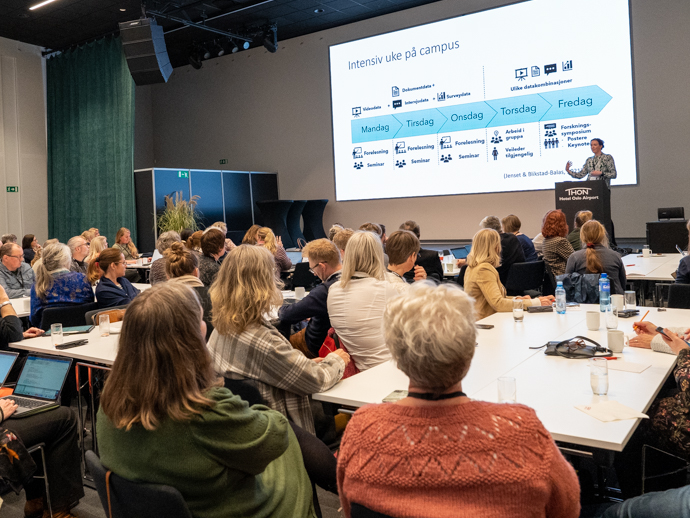The Teacher Education Conference gathered teachers, researchers and school leaders. The conference is organised by Universities Norway and is a key national forum for those working with teacher education.
Norwegian Minister of Research and Higher Education, Ola Borten Moe opened the conference. The topic this year was how teacher education can be innovated and improved.
Three QUINT researchers were invited to share their findings from two projects whose work stems from QUINT Theme 4: Developing video-based teacher training.

Analytical practice on campus
Marte Blikstad-Balas presented results from a project she conducted with QUINT researcher Inga Staal Jenset. The project focused on innovating the University of Oslo’s teacher education programme via an ‘analytical practice’ course.
“There is a consensus that teacher education needs to be more grounded in practice, and the assumption has been that this means more time spent in schools,” says Blikstad-Balas “but this does not have to be the case. What we’ve done in the analytical practice course is let teacher students engage in a case example while on campus by giving them artefacts from a real classroom to analyse.”
These artefacts include video footage of the lessons, interviews with the teacher and some students, documents from the lessons and a survey completed by students in the class. The teacher students are then tasked with providing an analysis of the practices taking place in the case example classroom.
There are several benefits to this approach, says Blikstad-Balas.
“One advantage is that it lets us break down classroom practices into discrete parts for the teacher students to analyse. It allows us to spend more time on each situation and play it many times if necessary.”
Added value for teacher students
The analytical practice course lasts one week and takes place during the teacher candidates’ 9th and final semester, their most advanced practice period.
The course is designed to train teacher students’ critical eye for teaching practices, and equip them with research literacy about how teaching is studied.
Jenset and Blikstad-Balas argue that if we want teachers who continue to learn and who are engaged with research on teaching, they need to be given insight into how this research is conducted, and to learn how they can decompose the complexity of the classroom.
Blikstad-Balas and Jenset conducted surveys and focus group interviews of the teaching students after they had completed the five-day course.
“A central question for us has been whether the students feel the analysis practice has made them better at reflecting on their own and others teaching, and our results indicate that they do,” says Jenset.
Learning to notice
Jenset also co-presented results from the “Learning to notice in teacher education” (LTN) project, together with QUINT Doctoral Research Fellow Gøril Brataas.
Learning to notice investigates the use of video as tool in teacher education, combined with a specific attention to certain teaching practices.

The project follows two cohorts of student teachers, engaged in a video-based methods course in Norwegian language arts.
Like the 'analytical practice' course, LTN uses videos to illustrate complex teaching practices during coursework at campus, and to relate theoretical concepts to actual classroom practice.
The course trains the student teachers’ ability to identify, analyse and reason around relevant classroom events. The project also examines how this ability is related to the student teachers’ teaching repertoire.
During the project period seven student teachers were followed into their teaching placements, where they videotaped their own teaching and discussed the recordings with their mentors.
“Student teachers find this use of video very helpful. It allows them to point out and analyse very specific things they did or didn’t do, or attend to, during a lesson,” says Brataas. “We see that this makes the mentoring conversations more targeted, and enables them to go deeper into details of very complex teaching practices.”
Several papers from the Learning to notice project are awaiting publication later in the year.
Related material
- Journal aticle: "Innovative design of fieldwork in teacher education: Using artefacts of practice to prepare for teaching and research in the profession."
- Theme 4: Developing video-based teacher training.
- Project: Learning to notice in teacher education: The use of video as an instructional tool.
- Conference page: Lærerutdanningskonferansen 2023.
- Web article: "New project to study teacher education in Iceland."
Watch – How video is used in teacher training and professional development at QUINT.
